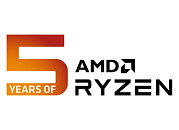- Joined
- Oct 9, 2007
- Messages
- 47,933 (7.37/day)
- Location
- Dublin, Ireland
| System Name | RBMK-1000 |
|---|---|
| Processor | AMD Ryzen 7 5700G |
| Motherboard | Gigabyte B550 AORUS Elite V2 |
| Cooling | DeepCool Gammax L240 V2 |
| Memory | 2x 16GB DDR4-3200 |
| Video Card(s) | Galax RTX 4070 Ti EX |
| Storage | Samsung 990 1TB |
| Display(s) | BenQ 1440p 60 Hz 27-inch |
| Case | Corsair Carbide 100R |
| Audio Device(s) | ASUS SupremeFX S1220A |
| Power Supply | Cooler Master MWE Gold 650W |
| Mouse | ASUS ROG Strix Impact |
| Keyboard | Gamdias Hermes E2 |
| Software | Windows 11 Pro |
AMD disrupted a decade of $350 quad-core from Intel with its path-breaking Ryzen processor and the "Zen" microarchitecture, which enters 5th year in the market (5 years since tapeout). AMD went into the Ryzen processor launch as a company that had been written off in the CPU space by PC enthusiasts, and "Zen" was at best expected to give AMD another round of processors to sell around $250. Boy was everyone wrong. The Ryzen 7 1800X eight-core processor brought HEDT-levels of performance to the mainstream desktop form-factor, and its HEDT counterpart, the Threadripper, dominated Intel's Core X series ever since.
Intel's first response to the 1800X was a 50% increase in CPU core counts calculating that AMD would only see marginal IPC increases going forward, and the superior IPC of "Skylake" cores, along with a 6-core/12-thread setup in the Core i7-8700K would see things through. This is roughly when Intel faced severe supply shortages that spiraled prices out of control, giving AMD space to come out with the Ryzen 7 2700X with a 4% IPC increase, and improved multi-threaded performance, but more importantly, predictable pricing at around $330. Months later, Intel refreshed its lineup with the 9th Gen, and finally attained parity with AMD in core counts, with the Core i9-9900K.

The i9-9900K put Intel back into the hands of the enthusiasts on account of high IPC and core-counts. AMD responded with the unthinkable—doubling CPU core counts to 16, and the "Zen 2" microarchitecture posting a double-digit % IPC increase. These took the performance crown away from Intel, which could only clutch on to the slightly higher IPC of its CPU cores, which resulted in higher gaming performance. The 10th Gen i9-10900K dialed core-counts up to 10 and no further, as Intel had hit the upper limits of how many cores it could cram into a 14 nm silicon that fits on Socket-Hx. AMD's posted a consecutive double-digit IPC gain with "Zen 3," which finally took the performance crown away from Intel. Having ceded the multi-threaded performance space squarely to AMD, Intel thought it could develop a gaming powerhouse processor despite being limited to 14 nm, and came up with the 11th Gen "Rocket Lake." Its gaming performance fell short of expectations, and AMD remains the brand of choice for PC enthusiasts. Intel is once again looking to change this, with the 12th Gen Core "Alder Lake." We'll know soon enough if it succeeded.
View at TechPowerUp Main Site
Intel's first response to the 1800X was a 50% increase in CPU core counts calculating that AMD would only see marginal IPC increases going forward, and the superior IPC of "Skylake" cores, along with a 6-core/12-thread setup in the Core i7-8700K would see things through. This is roughly when Intel faced severe supply shortages that spiraled prices out of control, giving AMD space to come out with the Ryzen 7 2700X with a 4% IPC increase, and improved multi-threaded performance, but more importantly, predictable pricing at around $330. Months later, Intel refreshed its lineup with the 9th Gen, and finally attained parity with AMD in core counts, with the Core i9-9900K.

The i9-9900K put Intel back into the hands of the enthusiasts on account of high IPC and core-counts. AMD responded with the unthinkable—doubling CPU core counts to 16, and the "Zen 2" microarchitecture posting a double-digit % IPC increase. These took the performance crown away from Intel, which could only clutch on to the slightly higher IPC of its CPU cores, which resulted in higher gaming performance. The 10th Gen i9-10900K dialed core-counts up to 10 and no further, as Intel had hit the upper limits of how many cores it could cram into a 14 nm silicon that fits on Socket-Hx. AMD's posted a consecutive double-digit IPC gain with "Zen 3," which finally took the performance crown away from Intel. Having ceded the multi-threaded performance space squarely to AMD, Intel thought it could develop a gaming powerhouse processor despite being limited to 14 nm, and came up with the 11th Gen "Rocket Lake." Its gaming performance fell short of expectations, and AMD remains the brand of choice for PC enthusiasts. Intel is once again looking to change this, with the 12th Gen Core "Alder Lake." We'll know soon enough if it succeeded.
View at TechPowerUp Main Site












